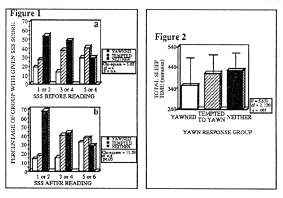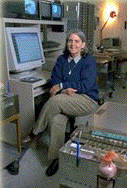Reading about yawning can elicit yawns
and is a more effective stimulus than reading a
control passage. We wished to examine whether
yawning is elicited more easily in students who
report greater levels of sleepiness.
Methods : While seated in a large
auditorium, students enrolled in a course on
sleep and dreaming but naive to inforrnation on
yawning were ask-ed to complete the Stanford
Sleepiness Scale (SSS) and then were given one
of two brief passages to read, with instructions
to "remain absolutely quiet and do not look
around the room" while reading. A 5 minute
reading period was provided. Students were
instructed to re-read the passage if they
finished early. One passage ("Yawn") described
yawning and was the passage previously used by
Provine; the
second ("Open Wide") was of equal length, but
described tonsils and tonsillitis in the context
of explaining why a doctor says "open wide and
say ah". Students were then requested to report
whether thev yawned, were tempted to yawn, did
not yawn, or could not remember having yawned
while reading the text. They also rated their
interest level in the reading (5-point
scale-very uninteresting to very interesting),
stated how much they had slept the night before,
indicated whether they felt the previous night's
sleep was sufficient (3-point scale-more than
suificient, sufficient, less than sufficient),
and finally gave another SSS rating. Responses
were completed by 130 students, ranging in age
from 16 to 22 (mean = 19.3, S.D. = 1.3) years.
The Yawn text was read by 32 women and 31 men
and the Open Wide text by 40 women and 27 men.
No sex differences were found for any variable;
therefore, the data were combined across
sexes.
Results : Of the 63 students who read
the Yawn passage, 20 reported yawning and 29
having been tempted to yawn; among the 67 who
read the Open Wide passage, 4 reported yawning
and 17 being tempted to yawn (chi-square = 32.
f-3 3; p<001). The level of interest was
significantly related to reports of yawning only
in the group who read the Open Wide passage;
thus, those who found the passage less
interesting were more likely to report yawning
or being tempted to yawn (chi-square = 10.77;
p<01). Figure shows that SSS ratings given
before reading either passage did not have a
statistically significant effect on reports of
yawning; however, SSS ratings given after
reading either passage showed a significant
relationship to yawning. Furthermore, reported
sleep time the night before the experiment was
significanny related to the likelihood of
yawning; those who reported yawning also
reported having had less sleep. Finally only in
the group who read the Yawn passage, ratings of
sleep sufficiency the night before showed that
when sleep was rated as insufficient, students
were significantly more likely to report yawning
or being tempted to yawn, than those who rated
sleep as sufficient or more than sufficient
(chi-square = 6.68; df = 1; p<01).
Discussion : Although our
previous study showed no relationship
between sleep the night before and likelihood of
yawning such a relationship occurred in the
present study. In addition, a subjective sense
of sleepiness measured by the SSS ratina given
after reading the text was also associated with
likelihood of yawning or being tempted to yawn,
even though SSS rated before reading the text
was not. At the same time, subjects reading the
more potent yawn-eliciting text were more likely
to yawn if they rated sleep as insufficient. We
suggest that individuals with a high
physiological sleep tendency (not measured
directly in this study) are more likely to yawn
when exposed to a yawn-inducing situation, as
indicated by the association of yawning with low
sleep times and ratings of insufficient sleep.
The yawn-eliciting text may "unmask" a high
level of physiological sleepiness that was not
apparent on the initial SSS ratings. We further
suggest that the occurrence of yawning may
itself serve as a cue for introspective ratings,
as marked by the closer relationship between
yawning or being tempted to yawn and SSS ratings
given after than those given before reading the
text. On the other hand, the students who yawned
may have simply decided they must be sleepier
than they first thought.



